Eight million years of Arabian climate were not all dry
DOI: 10.1063/pt.lrnf.pqde
If you’ve ever been in a cave full of long, spindly stalagmites and stalactites, you might recall a sound that frequently interrupts the otherwise cavernous silence: Drip, drip. The flow of water is the very reason the rock formations are there. When water saturated with calcium carbonate trickles into a cave, carbon dioxide degases from the water, and calcite crystallizes onto the cave’s surfaces. Layers slowly build up and, like tree rings, offer a record back through time.
The conditions needed to create those water-deposited cave rocks, collectively known as speleothems, are not what anyone would expect to find in the middle of a vast, barren desert such as the one in figure
Figure 1.
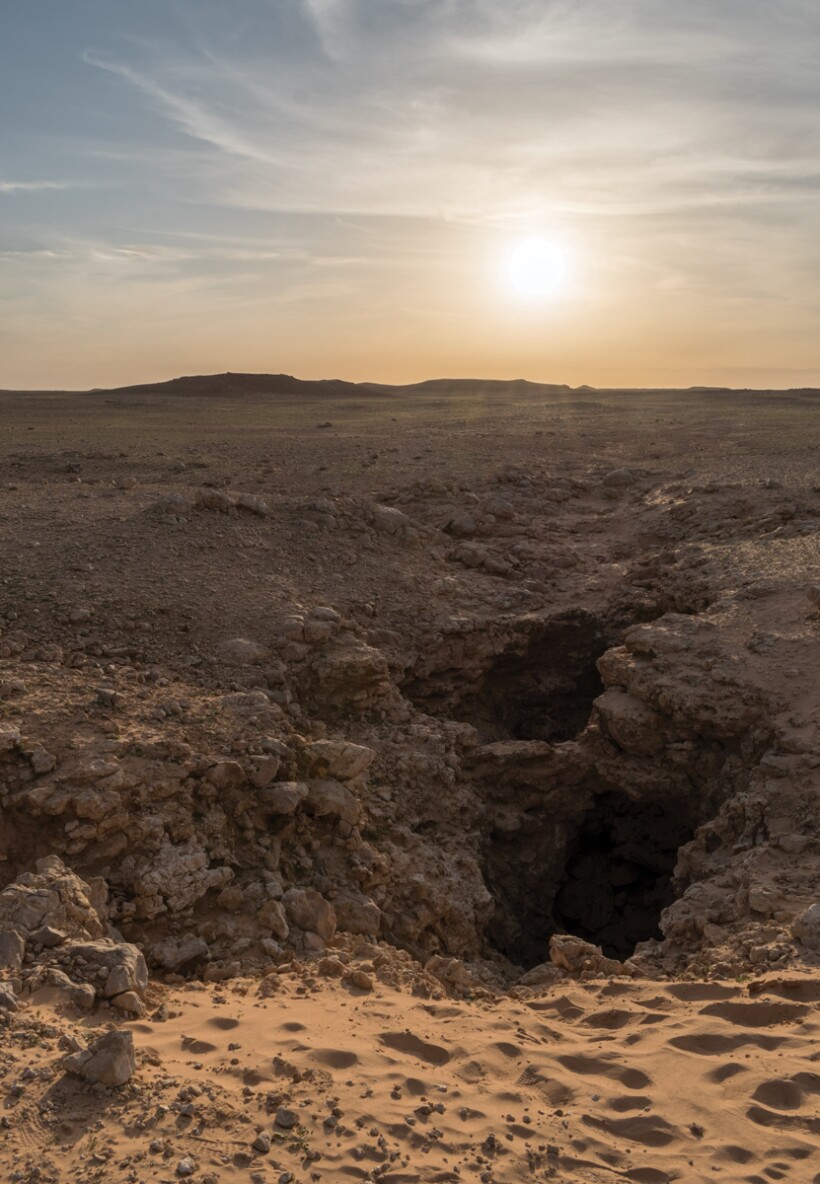
A cave entrance disrupts the vast expanse of rock and sand in the Arabian Desert. This and other caves in central Saudi Arabia contain stalagmites and stalactites—rocks formed by the seepage of water through soil and limestone—that reflect humid phases in the peninsula’s past. (Photo by Paul Breeze.)
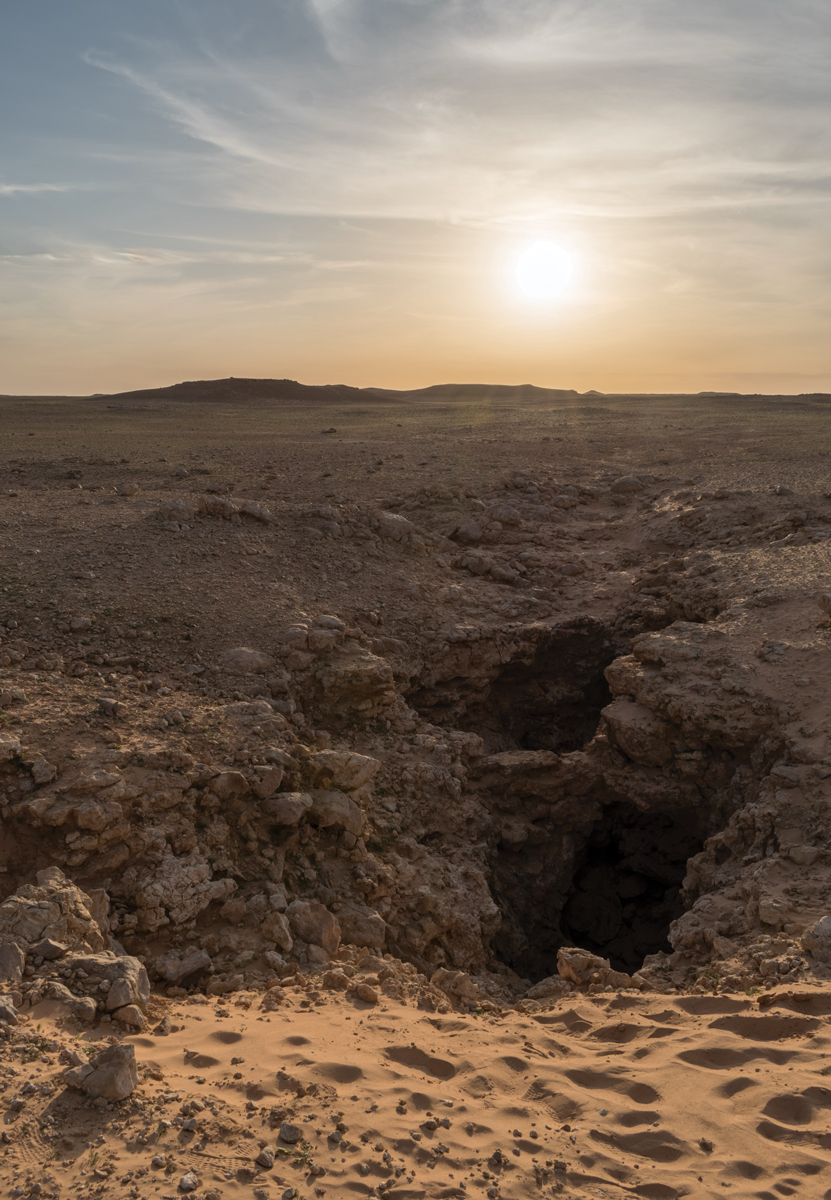
Now Monika Markowska (currently at Northumbria University in the UK but formerly with the Max Planck Institute for Chemistry in Germany) and colleagues have published their initial findings about the climate history recorded in those speleothems. 1 The researchers were stunned when they found that their samples date back nearly 8 million years, roughly an order of magnitude older than what they had expected, and about 7 million years longer than any existing climate record from the peninsula. They identified distinct humid periods, centered around 7, 4–3, 2, and 1 million years ago, during which the speleothems grew.
Back in time
The barrier posed by the vast expanse of the harsh Saharo-Arabian Desert is part of the reason Africa has so many unique, large animals. Recent research has documented that the desert’s presence goes back 11 million years. 2 The Arabian Peninsula is one of just a few geographies, which also include the Nile Valley and the narrow crossing at the Strait of Gibraltar, that archaeologists believe could have once served as a conduit for early human ancestors out of Africa and into Eurasia. Episodes when water-dependent animals took up residence in the area are reflected in the fossil record from the peninsula during two distinct time periods, the past 500 000 years and 7 million years ago, though little has been known about the climate of the intervening time span.
The long record collected from the speleothems can, ironically, be partially attributed to the desert environment: If wetter climate periods were more frequent or lasted longer, the older speleothem samples could have been covered up by younger ones. In the dynamic landscape of the desert, cave entrances, such as the one seen in figure
The standard method for dating speleothems relies on the ratios of parent isotope uranium-234 to its decay product thorium-230. It’s a handy tool for speleothem dating because uranium dissolves in water but thorium does not. So when a layer of calcite precipitates out of water, it contains uranium but no thorium. The fresh layer is a clean slate from which to measure the passage of time via the accumulation of thorium. But that technique can go back only about 600 000 years. After that, 230Th, a radioactive isotope, reaches an equilibrium value because it starts to decay at the same rate that it accumulates.
When Markowska started to investigate how old the speleothems are, she ran into a problem: 90% of the measurements were out of range for U–Th dating (see figure
Figure 2.
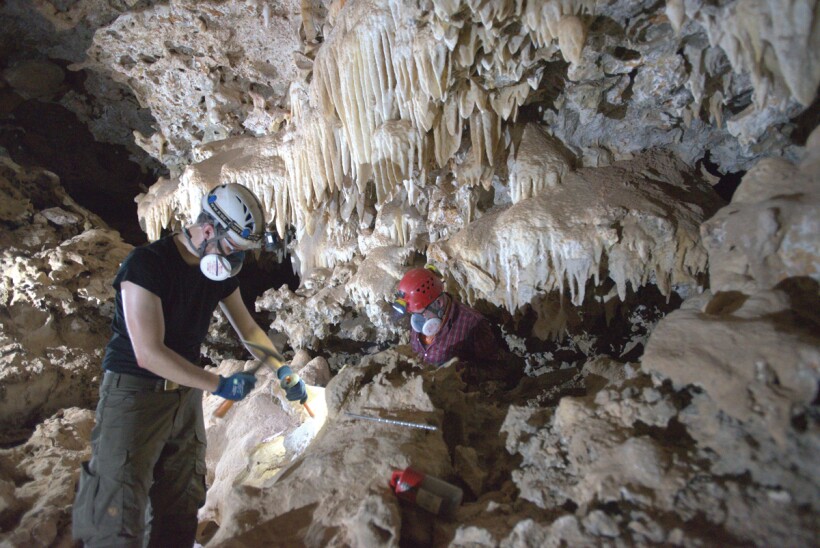
Speleothem samples from Mossy Cave in the Arabian Desert are collected by Alexander Budsky (left) and Hubert Vonhof (right). The cave’s name was inspired by mossy vegetation that grows at its mouth due to moist air that escapes from inside the cave. The rocks grew during humid intervals that span the past 8 million years. (Photo courtesy of the Green Arabia project.)
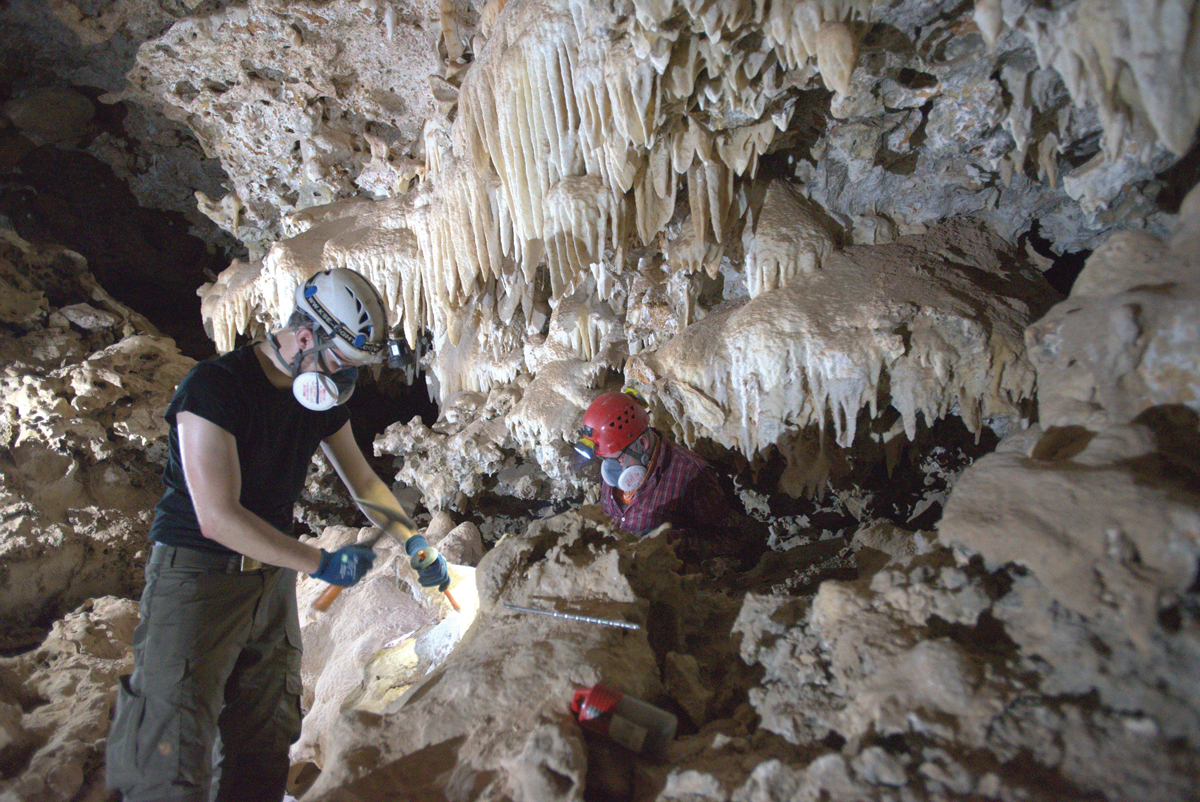
Undeterred, the team turned to another radioactive timekeeper: uranium–lead dating. That approach relies on two radioactive decay chains: 238U to 206Pb and 235U to 207Pb. Age calculations require corrections for the initial ratios of uranium isotopes in a sample. The researchers calculated averages for those initial values using the younger sections of rocks dated with U–Th ratios. The need for such corrections yields larger uncertainties compared with U–Th ages.
Uranium–lead dating can also be challenging, in part because lead is everywhere, so samples are easily contaminated by something as simple as dirt. “It was a little bit lucky that uranium–lead dating worked. The samples were quite pristine,” says Vonhof. Contamination from dirt can often be seen in the lab when speleothems are processed, but excess lead also stands out in the isotope measurements. The use of laser ablation, rather than standard solution chemistry, to perform spectroscopy also enabled faster U–Pb dating of more samples.
Fossil water
More luck came in the form of water that was directly sourced from the past; it was trapped in the calcite crystal lattice of the speleothems. The source of water can be fingerprinted by the relative ratios of 18O to 16O and 2H to 1H and compared with global databases. Stable isotopes of hydrogen and oxygen from the water show that it originated from a seasonal, southerly source of moisture brought in by monsoonal winds moving through the Arabian Sea and the Gulf of Aden.
In contrast, the sparse, modern rainfall comes from a combination of northern and southern sources, with no strong seasonal signal. As the source of rainfall at the Arabian cave sites changed slowly over time to more northern sources, the overall Arabian climate was getting drier. Even the humid periods became less humid. The aridification trend is reflected not only by the oxygen isotope measurements from the trapped water and calcite, because heavier oxygen isotopes are enriched during drier periods, but also by the crystal structure of the calcite: During the older wet phases, larger calcite crystals could grow.
One of the geographically nearest paleoclimate records to date is from an area in the Zagros Mountains in Iran, about 1000 km north of the Arabian cave sites; the sedimentary rocks there show hyperaridity over the period spanning 5.6–3.3 million years ago. 3 The new data that show a humid phase from 4 to 3 million years ago complicate that picture and illuminate some of the geographic variability of the climate at the time.
Figure 3.

A stalagmite cross section from Mossy Cave is one of many used to extract radioisotope ages that illuminate the timing of humid phases on the Arabian Peninsula. Uranium–thorium ratios (blue) are analyzed from chemical solution and can measure back only about 600 000 years. Uranium–lead ratios (black) measured with laser ablation show that samples date back several million years (Myr). Red arrows point to hiatus periods during which there was no mineral growth on the stalagmite for an extended time. (Photos adapted from ref.
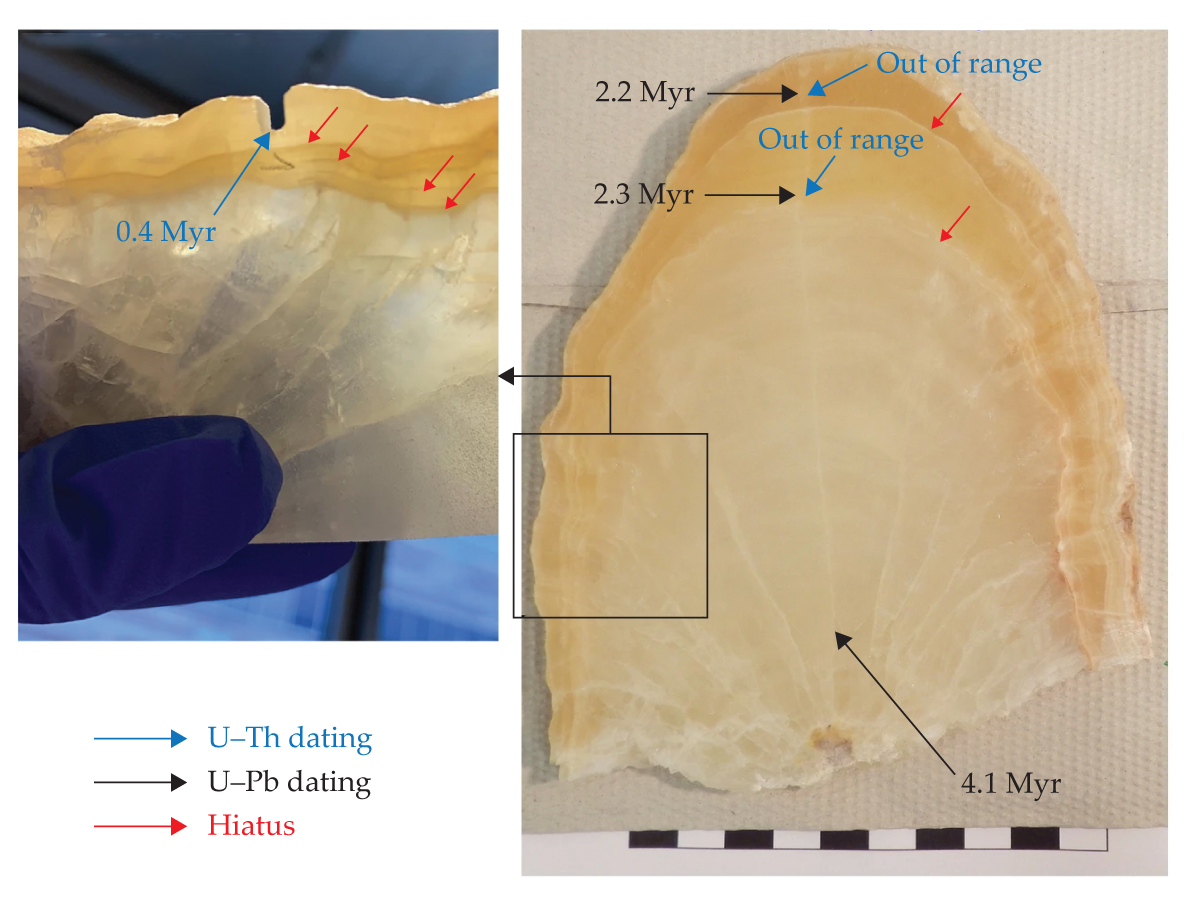
Miriam Belmaker, a paleoanthropologist at the University of Tulsa in Oklahoma, says that the speleothem data open a new line of consideration for the timing of and paths taken by hominins migrating directly across the southern or central Arabian Peninsula rather than north through the Levant region. (Hominins are members of the Hominini taxonomic tribe that includes humans and all our bipedal ancestors.) “Up to now, the dispersal routes through Arabia were not considered as viable,” she says. The Nile has been regarded as the more attractive passageway from Africa into Eurasia, but there’s no archaeological or paleontological evidence that correlates the region to the earliest established hominin dispersal about 2 million years ago.
“Humid periods in Arabia, where you can detect enough precipitation to have formed speleothems, could have supported a dispersal of humans,” says Belmaker. She points out that the humid period in the Arabian Peninsula from 4 to 3 million years ago could be especially important. There are archaeological sites in Asia, such as one at the base of the Himalayas that goes back 2.5 million years, 4 that contain stone tools and cut bones—evidence for an even older hominin presence outside Africa. But without a direct migration route in mind, those artifacts haven’t been widely adopted as significant findings worth further investigation. Belmaker expects the new climate data to motivate deeper exploration. Of course, dispersal and mixing of other animals and plants would also have been facilitated by those humid phases.
Aridification
Ratios of stable carbon isotopes from the speleothems hint at correlations between climate shifts and changing vegetation types in the region, toward vegetation more adapted to dry climates. But the researchers are hesitant to draw strong conclusions from the isotopes; instead, they are investigating further. The speleothems contain some preserved pollen, another rare find for the region. Analyses of the pollen are underway and could provide a stronger picture of the evolving ecosystem and climate.
The age data extracted from the cave rocks don’t provide strong constraints on the exact duration of wet and dry phases. It’s possible that those phases occurred over even narrower ranges of time: tens to hundreds of thousands of years. Data from hundreds of speleothems would need to be collected to provide robust population statistics that could narrow down the ranges, but analyzing so many samples would be prohibitively expensive. The longest apparent dry period in their data, from 6.3 to 4.1 million years ago, corresponds with a well-known climate event in the broader region known as the Messinian salinity crisis, during which the Mediterranean Sea nearly dried up.
In the portion of the speleothem record spanning the past million years, as the climate of the peninsula became progressively more arid, calcite stopped forming on the speleothems and was replaced by gypsum. A rind of gypsum left behind signifies the end of the standard mechanism for speleothem formation: Less water is needed, and it doesn’t have to travel through organic material to become acidic and dissolve limestone; gypsum can be dissolved more easily. Says Markowska, “We can really see the hydrological change reflected in the speleothems through time.”
This article was originally published online on 27 May 2025.
References
1. M. Markowska et al., Nature 640, 954 (2025).https://doi.org/10.1038/s41586-025-08859-6
2. A. J. Crocker et al., Nat. Geosci. 15, 671 (2022).https://doi.org/10.1038/s41561-022-00990-7
3. M. Böhme et al., Commun. Earth Environ. 2, 85 (2021).https://doi.org/10.1038/s43247-021-00158-y
4. D. Cauche et al., L’Anthropologie 125, 102846 (2021).https://doi.org/10.1016/j.anthro.2021.102846

